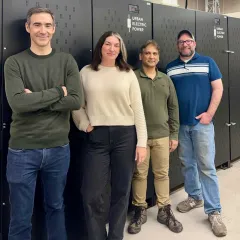FOR IMMEDIATE RELEASE
S&T Public Affairs, 202-286-9047
Competition Crowdsources, Engages Citizen Inventors Directly to Find Promising Clean Energy Storage Solutions
WASHINGTON – As the Biden-Harris Administration celebrates Earth Day, the Department of Homeland Security (DHS) announced the five winners of the Clean Power for Hours Challenge, awarding a total of $835,000 to recipients for their innovative clean energy solutions to keep essential services functioning during power outages. Developed by DHS’s Science and Technology Directorate (S&T) and Cybersecurity and Infrastructure Security Agency (CISA), the purpose of this Challenge, one in a series of DHS prize competitions, is to strengthen resilience to extreme weather events worsened by climate change and encourage the development of groundbreaking solutions for environmental hazards facing communities across the country.
Extreme weather has increased the frequency of power outages, with the average duration of electricity interruption exceeding five hours. Critical facilities that provide services and functions essential to a community during and after a disaster often rely solely on electricity for power. These include hospitals, water and wastewater treatment facilities, police and security services, and places of refuge. While critical facilities have backup generators onsite to supply electricity in the case of a grid failure, they typically rely on a finite supply of diesel fuel onsite. Affordable, easy-to-use, and environmentally friendly solutions supported by the Clean Power for Hours Challenge will improve energy reliability and enhance the resilience of National Critical Functions (NCF)—government and private-sector functions so vital that their disruption would debilitate security, the economy, public health, or safety.
“When disaster strikes, restoring electric power can quickly become a matter of life or death. It is required to keep utilities like water treatment plants running, emergency rooms operational, first responders in communication with each other, and much more,” said Secretary of Homeland Security Alejandro N. Mayorkas. “The Clean Power for Hours Challenge empowers some of our most creative citizen innovators to help strengthen the resilience of our critical infrastructure and support communities in their moment of need—all while moving our country towards a clean energy future.”
“As S&T contributes to the global response to climate change, we recognize the winners of the Clean Power for Hours Challenge and the next-generation technologies they are developing,” said Dr. Dimitri Kusnezov, DHS Under Secretary for Science and Technology. “The Challenge winners offer ready-to-field energy storage solutions with the potential to advance the DHS mission to strengthen national climate resilience and address supply chain challenges in sourcing minerals and materials for energy technologies.”
“CISA is proud to support the Clean Power for Hours Challenge. By its very nature, climate resilience is infrastructure resilience,” said CISA Director Jen Easterly. “Ensuring that lifeline critical infrastructure facilities have sustainable, robust back-up power solutions is paramount to maintaining the resilience of our nation’s infrastructure. This Challenge not only promotes the adoption of innovative, environmentally friendly energy solutions, but it also reinforces the importance of protecting the essential services that underpin emergency response, public health, and national security. We look forward to seeing these solutions in action.”
The Clean Power for Hours Challenge builds on federal government-wide efforts to stimulate innovation and partnership and expand the American public’s participation in science. A panel of judges who are experts in climate change, resilience, and energy storage selected the winners using specific selection criteria and hypothetical use to identify solutions that can provide backup power to small-scale facilities or utility assets as a substitute for fossil fuel-powered generators.
The Challenge had two stages. During Stage 1, DHS awarded nine finalists $15,000 each for a written or video submission describing how their solution meets the judging criteria. Those finalists progressed to Stage 2, where they conducted live demonstrations of their technology solutions at facilities or customer sites for judges to assess.

The Grand Prize winner awarded $400,000:
- Urban Electric Power, Inc. (Pearl River, NY), for its Rechargeable Zinc-Manganese Dioxide Battery Energy Storage System. The technology uses the chemistry found in alkaline batteries to make a rechargeable battery system for stationary energy storage applications. This solution is easy to use and safer for critical infrastructure in most need of protection than lithium batteries and cleaner than fossil fuels.
The Runner-up awarded $200,000:
- Dr. Hari Dharan, Omnes Energy (Woodland, CA), for his Long Duration Power Delivery for Critical Infrastructure, a non-lithium technology that uses an electromagnetically suspended steel rotor (flywheel) coupled with a motor/generator. The flywheel generates back-up power and is easy to run and fix during an emergency.
The “Innovator” Honorable Mention awarded $50,000:
- The startup company ElectricFish (Fremont, CA) for its 350squared technology—a containerized battery storage device which operates as a microgrid for local critical loads, distributed energy resource for the grid, and electric vehicle fast charger.
Other Honorable Mentions awarded $25,000 each:
- New Use Energy Solutions, Inc. (Phoenix, AZ) for the SunKit, an expandable battery + solar generator system and ONYX POWER LLC (Long Beach, CA) for its rugged, mobile, modular nanogrid that can recharge from the grid or solar.
DHS, S&T, CISA, and their government partners will continue working with the winners and provide for future opportunities, including assistance meeting mentors, establishing connections to technology accelerators, and finding opportunities to speak at conferences with broader security audiences.
To stay up to date with DHS S&T and prize competitions, visit the DHS Prize Competitions web page and follow DHS S&T on LinkedIn, X, Facebook, and Instagram.
###
